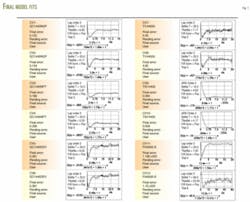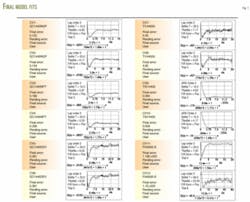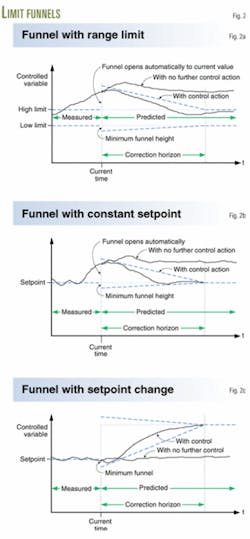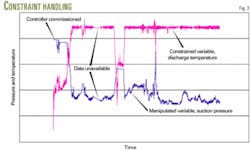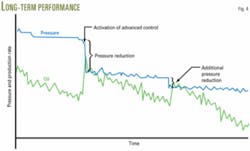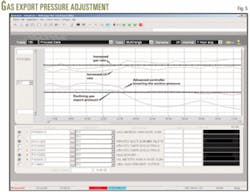Multivariable predictive control technology increased oil and gas production by 4% from BP PLC's Marlin tension leg platform (TLP) in the Gulf of Mexico.
While multivariable control technology is established in the petrochemical and refining industry, only a few offshore production facilities have this technology deployed.
On Marlin, BP installed the Honeywell Profit Controller technology between July and October 2003.
The Marlin TLP is on Viosca Knoll Block 915 in 3,240 ft of water.
Production constraints
Space constraints on offshore facilities limit the design of separation equipment. Multivariable predictive controllers, a component of advanced process control (APC), are suited for operations that have process constraints and require significant interaction between variables. APCs, therefore, offer a way for operating the offshore facility at or near the prevailing constraint to maximize the production.
BP has successfully used APC on its offshore production facilities.1 In its first implementations of APC on an offshore platform in Europe, BP achieved a 2% increase in the production rate.
On the Marlin TLP, BP chose APC technology to maximize the production because several constraints limited production. Depending on operating and weather conditions, these constraints would change from active to inactive and vice versa. It was, therefore, difficult for the operators to maximize production continually.
Process description
The Marlin TLP processes oil, gas, and water from several dry-tree wells and subsea wells. Currently Marlin receives production from three oil fields. The facility separates the oil, gas, and water before the oil and gas enters pipelines that carry the fluids ashore.
On Marlin, the feed goes to three process vessels that normally operate in parallel: the high pressure, intermediate pressure, and test separators. Operators control the feed to each separator through a production manifold and sometimes take the test separator offline.
The gas from the separators goes to a parallel compression train that compresses the gas to pipeline pressure.
After appropriate treatment, the facility discharges the water overboard.
Oil from each of the three separators enters a low-pressure separator that further separates the oil from water and gas. Gas from this separator goes to the compressors with the water, after treatment, being discharged overboard.
A degasser and electrostatic treater further processes the oil from the low-pressure separator before several parallel pipeline pumps move the oil ashore.
When BP started the initial discussion about implementing an APC system on Marlin, the oil pump motors limited the facility's processing capacity. When the project work had started, however, the key constraints had shifted. The pump motor capacity no longer limited the oil production rate. Instead, the primary compressor system was now the constraint.
In the facility, the oil and gas production rate is inversely proportional to the well pressure set by the primary compressor system's suction pressure. Thus, the APC system design had to maximize the production rate subject to the compressor system constraints.
APC design
Honeywell's Profit Controller is a multivariable predictive controller that has been used in the refining and petrochemical industry. The controller uses three types of process variables for control input and output, as follows:
1. Controlled variables (CVs) are the process variables that must be maintained at some value or within limits and may be optimized. The operator inputs CV limits, which are measured or calculated values. For each CV, the user specifies a tuning parameter, the performance ratio, that determines how aggressively the controller will act to keep this CV within its limits. This is the primary tuning parameter for the controller and can be changed while the controller is online.
2. Manipulated variables (MVs) are the handles that are adjusted to keep the CVs within limits (or at setpoints) for optimizing the process. The controller always honors MV limits established by the operator. The MV is either a regulatory controller's set point (SP) or output (OP). For each MV, the user specifies an MV weight that determines the relative movement of MV when the controller has more than one MV to achieve the desired results. MV weights do not affect how aggressively the controller will bring the CVs within their limits.
3. Disturbance variables (DVs) are measured variables that are not under control of the controller but affect the controller's CVs. By predicting the DV effects on the CV trajectory, the controller can take actions to prevent CV excursions.
One of the core technologies of the Profit Controller is a patented range-control algorithm. It controls all CVs within their ranges, recognizing that a setpoint is simply a special case of a range. The algorithm enables the controller to explicitly constrain all of the CVs dynamically into the future. It allows the number of CVs to be greater or fewer than the number of MVs output by the controller to achieve the CV constraints.
- Moving MVs the minimum amount required for achieving the control objectives.
- Having almost-parallel CVs (CVs that have similar gains and dynamics), which are controlled in a much more robust fashion than possible with conventional multivariable controllers.
- Using implicit unification of constraint control, regulatory control, and process optimization.
- Having constraints active only when they are limiting.
- Allowing versatile control performance adapts to changing degrees of freedom when plant loads and constraints change.
- Having CVs that may have integrating dynamics, such as tank levels.
- Keeping the Profit Controller online in situations where other multivariable controllers may become unstable.
Features of the algorithm include:
One key benefit of Profit Controller is its ability to control interacting process variables at specified setpoints. But the main benefit is that the controller allows a user to consider the process as a single entity rather than as a collection of isolated control loops. As such, the controller provides true process control by maintaining the process within operational constraints while simultaneously driving the process to an economic or operational optimum.
Ideal candidates for a multivariable-control application are processes that have one or more measurable constraints and operations with significant interactions between variables.
Various constraints on the primary compressor train limited Marlin production. The installed PlantScape Control system measures and provides access to all of these constraints. The controller included each constraint as a controlled variable or CV.
The controller also includes, as a DV or MV, each measured variable that affects the CV. The control matrix consists of all CVs, MVs, and DVs.
The final Marlin matrix included 1 MV and 12 CVs. The controller's optimization objective minimized the compressor's suction pressure while keeping the 12 CVs within their operator specified limits.
The controller incorporates a linear (LP) and quadratic (QP) programming optimization engine to drive the controller, and thereby the process, towards optimum operation. A user can specify the economic values for the MVs and CVs.
In the system, the operator interfaces with the controller through a Windows-based graphical environment called ProfitViewer.
Implementation control platform
Independent programmable logic controllers (PLCs) provide regulatory control on Marlin, while the compressor train has a Compressor Controls Corp. proprietary control system.
The operators interface with the PLCs and compressor control system through a Honeywell PlantScape system, which has redundant servers and operates as a SCADA system.
An APC computer implements all advance process control functions. The APC computer is a PC with a Windows 2000 operating system.
Profit Controller's interface to the PlantScape system is through Honeywell's Process History Database (PHD).
Design details
After defining the preliminary control matrix, the system designers step tested the process during which they upset each potential MV several times to capture its effect on CVs. The PHD collected these data that the Profit Controller's offline package, Profit Design Studio, used for generating process models.
Fig. 1 shows the final model file. Using the process models, the designers built the Profit Controller and tested it in a professional development schools (PDS) environment. The PDS generated all necessary files for online controller use.
PDS also provides an environment in which a user can simulate the controller behavior under any hypothetical condition. This is a very useful feature for tuning the controller and obtaining the operator's confidence in the controller.
The system includes PHD and Profit Controller online software installed on the APC computer and the graphical user interface, ProfitViewer, installed on operator stations. Operations of the Profit Controller commenced after connecting the APC computer to the control network.
Facilities operations involvement
One important aspect of the design effort was the involvement of the facility's operations staff. During the initial surveys and testing, operations personnel provided key information on how best the facility operated in ideal and non-ideal conditions and where within the process did the constraints lay and under what conditions.
Based on these discussions, the survey team focused on the primary compressor system and its constraints as the recommended system to apply multivariable control.
During the installation and commissioning, operations personnel performed the network installation of the new APC computer and assisted in the initial loading of the APC computer.
After a brief introduction of the controller technology and the use of the graphical interface, the operators entered the necessary control-variable limits and placed the controller in operation.
Operations
Several challenges exist for applying a multivariable controller on an offshore production facility. These include the production rate declining and wells added or taken offline during the life of a platform. Thus as the process models change over time, the control system requires a multivariable controller that is robust enough to handle a significant model mismatch. In addition, the system should allow a user to identify model mismatch and to update models without significant effort.
Additionally, the basic regulatory control system on an existing offshore platform typically consists of several PLCs. The control system, therefore, requires a multivariable controller that can interface with various types of controllers.
Honeywell's range-control algorithm enables the controller to handle significant model mismatch. The algorithm takes advantage of the range limits to improve the quality of control particularly when there are large model errors and a number of CVs interact strongly.
The algorithm uses the operator entered range limits directly in the dynamic control solution. This differs from traditional multivariable-control applications that use a steady-state optimization prior to the dynamic solution to generate setpoints (or trajectories) for the dynamic solution. As such, this provides the controller the freedom to allow a CV to be anywhere within its limits, instead of constraining it a particular value, or forcing it to follow a particular trajectory.
Additionally, from a mathematical, point of view, a typical multivariable controller inverts a matrix of the dynamic process model in order to calculate MV moves. If a control matrix contains constraints on highly interacting variables, it will be a poorly conditioned matrix and the solution will be highly sensitive to model errors.
With the algorithm, a constraint is active in the matrix only when the CV is at or outside its limit in the solution. In many cases, the correction of a particular CV that is outside its limit will also move interactive CVs inside or within their limits, so that only one of the interactive CVs is constrained in the solution matrix. As a result, the matrix is then well conditioned and less sensitive to errors. Thus, the algorithm enables the controller to handle model mismatch gracefully.
Limit funnels are another component of the controller that enables it to handle model mismatch.
The controller determines a CV's control horizon based on the performance ratio and the nominal open-loop settling time. The control horizon is the time in which the controller must return the CV within limits if a disturbance or limit change has caused it to be outside of limits.
The controller is free to determine any trajectory for the CV so long as it is within limits during the control horizon. This criterion allows the controller to determine a solution that will require minimum MV movement and will be least sensitive to model error.
Control systems use limit funnels to prevent the controller from transiently moving CVs outside their limits prior to their correction horizons. They accomplished this by defining constraints on the CVs that are imposed from the current interval out to the control horizon.
Fig. 2 illustrates limit funnels for different situations. The dashes show the constraints. The shape of the high and low constraint lines resembles a funnel turned on its side, with the mouth open beyond the operator-entered limits or CV value at the current time and narrowing to the limits at the horizon.
The controller calculates the funnel's opening beyond the limit or CV value at the current time. This allow for flexibility in control response, such as handling inverse response dynamics, while preventing an excessive amount of transient coupling of CV values. A user can configure the funnel type for varying applications.
The unbiased predication capability allows the user to pinpoint the submodel that has a mismatch. From this, the user can update the model parameters online without disabling the controller.
While the Profit Controller is tightly integrated with the Honeywell platform, its open architecture allows it to communicate with any open connectivity (OPC) compliant device.
Results
On Marlin, the controller minimized the suction pressure while honoring the process constraints, as defined by the operator. Initially, conservative limits artificially constrained the controller. But after testing the controller response, the operator slowly relaxed the constraints and the controller continued to drive the suction pressure down. Eventually, the controller encountered the true physical limit of the process.
Fig. 3 shows how the controller continued to drive the suction pressure down while honoring the predominant constraint, the gas discharge temperature. The pressure reduction is significant and dramatic. Obtaining approval for this change required substantial engineering effort to research and estimate the effect. The project team worked with the rotating equipment manufacturers, Compressor Control, Honeywell, and BP engineering and operations staff to define the optimal operating envelope.
Fig. 4 shows the long-term performance of the controller in reducing the suction pressure. This reduction in suction pressure resulted in a 4% increase in Marlin's oil and gas production rate.
Another benefit of the controller is that it exploits available opportunities to continually move the operation to an optimum. Fig. 5 shows this capability of the controller to adjust automatically for daily changes in constraints, such as gas export pipeline pressure.
Several factors contributed to the success of this project. These include the enthusiastic cooperation and support of the BP Marlin operations staff, support and information sharing from third party vendors, and support of BP internal staff.
Acknowledgments
We thank the management of BP and Honeywell for permission to publish this work.
Reference
1. Hocking, P., and Coward, A., "Applying Multivariable Control to the Offshore Oil Production Process," Honeywell User's Group Conference, Phoenix, Ariz., 1999.
The authors
Steve Cotton is the lead I&C engineer for BP's Marlin deepwater Gulf of Mexico asset and is based in Houston. He has 14 years of experience in the oil and gas industry. Cotton has worked as a lead control engineer on several major oil and gas development projects as well as field operations support.
Bob Peloubet is the deputy engineering authority for BP's deepwater Gulf of Mexico assets and is based in Houston. He has more than 20 years of experience in the oil and gas industry. Peloubet has worked as a lead control engineer on several major oil and gas development projects, as well being an engineering team leader in technology business units and operations business units.
Sanjay Sharma is a senior principal engineer with Honeywell Process Solutions in Houston. He has more than 22 years of experience in all aspects of process control and modeling. Sharma has a BS in chemical engineering from Mississippi State University.
Anil Gokhale is the advanced services engineering manager for Honeywell Process Solutions, Houston. He is responsible for the advanced process control, simulation, and optimization business. Gokhale has a BS in chemical engineering from the University of ombay, and a PhD in chemical engineering from Oklahoma State University.
